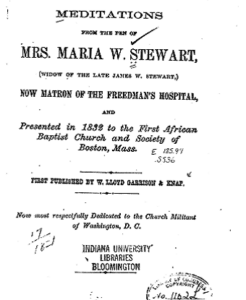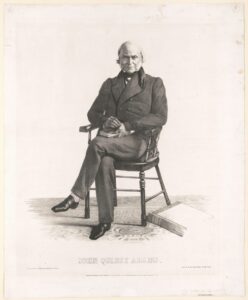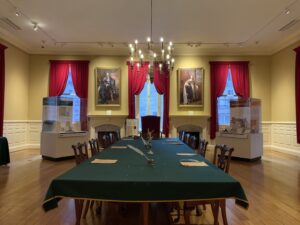
Abolitionist Petitioning and the Gag Rule

Written by Walter Wexler
On January 28, Revolutionary Spaces’ newest exhibit, The Humble Petitioner: Fighting for Rights in 18th Century Massachusetts, opened in the Old State House Council Chamber. This exhibit explores petitions as an essential tool of enfranchisement for colonial Bostonians who were denied the right to vote.
Petitioning was an indispensable part of civic engagement to colonists, but the power of petitions has slowly diminished over the centuries. While petitions played an important role in the abolitionist movement, the Gag Rules of the 19th century and free speech debates in the 20th century have only diminished their power further. How did our nation’s petitioning culture change so radically?
Brought with the Mayflower
Petitioning arrived in North America alongside the English colonists as a well-established avenue for governmental participation. The most important aspect of the right to petition was the understanding that the legislative body who heard a petition was obligated to respond. This norm enshrined trust between the petitioners and the petitioned, guaranteeing the viability of petitioning as a way to enact change.
After the revolution, petitioning persisted in the Constitution, despite debates over how powerful it ought to be. The first amendment states, “Congress shall make no law… Abridging the freedom of speech, or of the press, or the right of the people peaceably to assemble, and to petition the government for a redress of grievances.”1
Black Activism and Petitioning

The right to petition was an opportunity for disenfranchised Americans to fight for their rights, and in the early 19th century, it was being used to build support for anti-slavery movements. By the 1830s, the abolitionist movement had split into factions. The most radical were the ‘immediatists,’ who called for the total and immediate abolition of slavery. This faction became dominant through activism, including mass petition drives advocating for the abolition of slavery in the District of Columbia.
Maria Stewart’s “Meditations,” delivered in Boston in 1832. Library of Congress Blog.[/caption]In Boston, Black abolitionist Maria Stewart spoke at lecture halls and anti-slavery societies where she preached love amongst Black Americans and doom for whites who would oppose abolition. One way to achieve her vision of the United States was via petitions. In an 1833 speech at the African Masonic Hall, Stewart implored, “Let every man of color throughout the United States […] sign a petition to Congress to abolish slavery in the District of Columbia, and grant you the rights and privileges of common free citizens.” Her speeches were published in the widely-read newspaper The Liberator.2
A Dutiful Representative

Spurred by petition drives like those published in The Liberator, citizens submitted petitions for abolition to Congress. Tension between members of the House of Representatives heated up over the issue of how to respond to these divisive documents. John Quincy Adams, a Massachusetts representative, came to center stage in this controversy.
Adams consistently presented petitions from his district for the abolition of slavery. Though Adams refused to publicly state his opposition to slavery, and was content to let the petitions “sleep the sleep of death” after being read, he insisted on the governmental duty to respond to the people’s grievances and presented each petition to the House.3
Congressional Backlash
Hardline southern congressmen like John Calhoun and John Mercer Patton, however, insisted that the petitions be tabled without being read. They felt these petitions threatened the right of the South to continue enslaving Black Americans.
Adams illustrated this in a letter to his constituents, recounting when a pro-slavery representative said, “If any man should disgrace the government […] by presenting a petition from slaves praying for emancipation, the petition should, by order of the house, be committed to flames.” Another member chimed in, “The man who should present the petition should also be consigned [to combustion].”4
In February 1836, South Carolina congressman Henry Pinkney pushed for a committee that would say that Congress had no authority to legislate on slavery. He got the committee, but it would only conclude that Congress should automatically table petitions relating to abolition. This was the hardline position that southern congressmen had been advocating for years, known as the Gag Rule.5
The Beginning of the End
The Gag Rule effectively silenced any potential legislation that could come from petitioning, but it did not silence petitioners. In fact, petitioning drastically increased in the year after the Gag Rule was passed, with the number of anti-slavery petitions received by Congress exploding from 23 in December 1835 to more than 300,000 by May 1836. All of them were tabled without discussion. This wave of petitions ridiculed Congress’ inability to deal with the most contentious issue of the time.6
The Gag Rule was repealed in 1844, but the once paramount concept that the government had a duty to respond to petitions had evaporated under years of neglect. Petitioners could no longer expect that government bodies would issue responses to or even read their petitions. This decade signaled the end of the right to petition as a guaranteed way to express grievances to the government.
Petitioning Today

The setbacks petitions suffered in the abolitionist period represent not the failure of a government to listen to its people, but a petitions campaign so powerful that it polarized Congress. Facing a threat to the slave economy, anti-abolitionist congressmen crippled the mechanism.
Americans continue to petition, but have never reached the same volume as in the 1830s and 1840s.7 The influence of modern petitions might not be immediately obvious today, but petitioning our government and international organizations is still a powerful means of expressing political beliefs.
Come to Revolutionary Spaces to see our new exhibit, The Humble Petitioner: Fighting for Rights in 18th Century Massachusetts and explore this subject further!
Sources:
- U.S. Const. Amend. 1
- Henderson, Christina. “Sympathetic Violence: Maria Stewart’s Antebellum Vision of African American Resistance.” MELUS 38, no. 4 (2013): 52–75. http://www.jstor.org/stable/24570017.
- Adams, John Quincy. Letters from John Quincy Adams to His Constituents of the Twelfth Congressional District in Massachusetts: To which is Added His Speech in Congress, Delivered February 9, 1837. India: I. Knapp, 1837
- Ibid., 11
- Frederick, David C. “John Quincy Adams, Slavery, and the Disappearance of the Right of Petition.” Law and History Review 9, no. 1 (1991): 113–55. https://doi.org/10.2307/743661.
- Ibid., 132
- Ibid., 119-120. ; Blackhawk, Maggie, Daniel Carpenter, Tobias Resch and Benjamin Schneer, “The Contours of American Legislative Petitioning, 1789-1949: A New Database,” https://dcarpenter.scholar.harvard.edu/files/dcarpenter/files/contours.pdf

